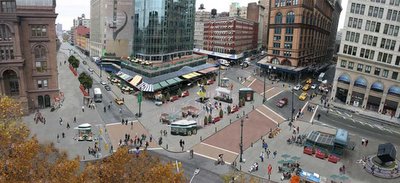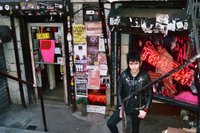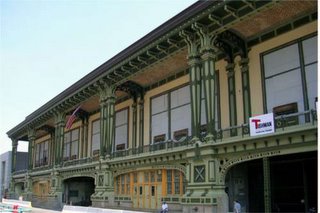
Round and round we go, where it stops, nobody knows ...
New York City, Ground Up: The built, the virtual, the bizarre, the wonderful.
 The default mode here at Polis is urban planning and city life in New York. But I also appreciate good design, which of course knows no city boundaries. One of the more interesting blogs about design is Inhabitat, and just a quick perusal this morning yields these little gems: rubber sidewalks made of recycled tires that are easily replaced and don't require tree removal; bamboo design; gorgeous cork floor tiles; and lots of prefab home designs. It's a great site.
The default mode here at Polis is urban planning and city life in New York. But I also appreciate good design, which of course knows no city boundaries. One of the more interesting blogs about design is Inhabitat, and just a quick perusal this morning yields these little gems: rubber sidewalks made of recycled tires that are easily replaced and don't require tree removal; bamboo design; gorgeous cork floor tiles; and lots of prefab home designs. It's a great site.
 Forgotten New York has a post today adding to its previous coverage of exposed trolley tracks that were once paved over but refuse to go away. It's interesting to note that the same General Motors that could very well go out of business in the early part of the 21st Century was largely responsible for having trolleys removed in the early part of the last century: "By 1948, all the trolleys were gone to be replaced by buses. It has been alleged that General Motors and an unspecified tire company conspired to speed the trolleys' demise," notes Forgotten NY. Here's an idea: let's intentionally expose the tracks and put trolleys on them again ... not the old-fashioned, tourist attraction trolleys, but modern trolleys that are springing up in cities all over America and actually help the city function with less pollution and impact on the enviornment. Read more about trolleys on Forgotten New York here.
Forgotten New York has a post today adding to its previous coverage of exposed trolley tracks that were once paved over but refuse to go away. It's interesting to note that the same General Motors that could very well go out of business in the early part of the 21st Century was largely responsible for having trolleys removed in the early part of the last century: "By 1948, all the trolleys were gone to be replaced by buses. It has been alleged that General Motors and an unspecified tire company conspired to speed the trolleys' demise," notes Forgotten NY. Here's an idea: let's intentionally expose the tracks and put trolleys on them again ... not the old-fashioned, tourist attraction trolleys, but modern trolleys that are springing up in cities all over America and actually help the city function with less pollution and impact on the enviornment. Read more about trolleys on Forgotten New York here.

 The Center for Architecture has announced a New York New Visions public forum on Feb. 28 (6-8 pm). The speakers: Stefan Pryor, President, Lower Manhattan Development Corporation, and Steve Plate, Director of Capital Projects, Port Authority of New York and New Jersey. The topic: "an informative discussion of how the individual projects at the WTC site will relate together." Here's an informative opening salvo: They don't relate. At all. Discuss.
The Center for Architecture has announced a New York New Visions public forum on Feb. 28 (6-8 pm). The speakers: Stefan Pryor, President, Lower Manhattan Development Corporation, and Steve Plate, Director of Capital Projects, Port Authority of New York and New Jersey. The topic: "an informative discussion of how the individual projects at the WTC site will relate together." Here's an informative opening salvo: They don't relate. At all. Discuss. Last week when Mayor Michael R. Bloomberg made another plea for development proposals for Governor's Island and revealed Santiago Calatrava's vision for gondolas linking Lower Manhattan and Brooklyn to the Island, I was tempted to nominate this for another edition of Breathtaking Inanity. But I quickly realized it's meant to be just a teaser, so I didn't bother.
Last week when Mayor Michael R. Bloomberg made another plea for development proposals for Governor's Island and revealed Santiago Calatrava's vision for gondolas linking Lower Manhattan and Brooklyn to the Island, I was tempted to nominate this for another edition of Breathtaking Inanity. But I quickly realized it's meant to be just a teaser, so I didn't bother."[C]onjuring an image for the island's future will be left up to developers. ... Not all countries operate this way. In Spain and the Netherlands, city and regional governments typically organize elaborate design competitions for a major urban site, then hire a developer to figure out how to put the idea into practice.
An aggressive government role in galvanizing the best creative minds is virtually nonexistent in the United States, where political and financial power has shifted to the private realm. That's why New York has fallen behind cities like Barcelona, Rotterdam and even London in terms of the level of ambition behind public works projects. In New York, the system can foster a poisonous mix of political self-interest and commercial greed, as it did at ground zero.
And there you have it, the problem in a nutshell. One of the first pieces I wrote as a brand new freelancer in New York City was for Metropolis magazine that touched on this very issue. An urban planning firm founded in Amsterdam had opened an office in New York in hopes of applying their waterfront redevelopment expertise here. As far as I know, since then they've had one New York client in four years because we DON'T PLAN HERE. We throw designs at the wall and see what sticks. Is it any wonder then that Governor's Island, perhaps the most intriguing piece of developable land in the Northern hemisphere, has been collecting dust since the Coast Guard abandoned it more than ten years ago? I love the web. I love blogs. I love the whole damn digital thing. Why? Because it allows smart, interesting and cool people like David Zeev Krieger to get in contact with me. He has a new blog called Distressed Property, which consists of a handful of short videos he's made of, you guessed it, distressed properties around New York City. You can read his quick bio for yourself, but it ends with this bit of real estate intrigue: "now living in new york working to encourage buyer driven real estate development." I'm looking into exactly what that means, and might even do a real estate story about it. But in the meantime, Distressed Property has a handful of very cool short videos. Check them out here.
I love the web. I love blogs. I love the whole damn digital thing. Why? Because it allows smart, interesting and cool people like David Zeev Krieger to get in contact with me. He has a new blog called Distressed Property, which consists of a handful of short videos he's made of, you guessed it, distressed properties around New York City. You can read his quick bio for yourself, but it ends with this bit of real estate intrigue: "now living in new york working to encourage buyer driven real estate development." I'm looking into exactly what that means, and might even do a real estate story about it. But in the meantime, Distressed Property has a handful of very cool short videos. Check them out here.

 I'm momentarily breaking my silence here on Polis (see next item), but since I've already wasted time today doing a post for the Times real estate blog about a record-breaking sale in Manhattan, here's the scoop: Over at The Walk-Through, "Give Us Your Rich, Your Famous..." is about a townhouse on W. 10th Street that sold for $11.5 million. This breaks the previous record for a single-family home below 34th street of $9.3 million on E. 11th St. The buyer is listed as Doves' Nest NYC LLC, but who that is exactly remains unknown ... for now. Anyone got more info?
I'm momentarily breaking my silence here on Polis (see next item), but since I've already wasted time today doing a post for the Times real estate blog about a record-breaking sale in Manhattan, here's the scoop: Over at The Walk-Through, "Give Us Your Rich, Your Famous..." is about a townhouse on W. 10th Street that sold for $11.5 million. This breaks the previous record for a single-family home below 34th street of $9.3 million on E. 11th St. The buyer is listed as Doves' Nest NYC LLC, but who that is exactly remains unknown ... for now. Anyone got more info? I'm going to be taking a break from Polis (and the Times) for a week or better to work on a book chapter. Meanwhile, check out a contest I'm helping to jury (click here or go to Your Hidden City) to get details of the first open source architecture photo contest, led by Tropolism. I've been looking at the photos so far, and Hidden City is already shaping up to be a high calibre international contest.
I'm going to be taking a break from Polis (and the Times) for a week or better to work on a book chapter. Meanwhile, check out a contest I'm helping to jury (click here or go to Your Hidden City) to get details of the first open source architecture photo contest, led by Tropolism. I've been looking at the photos so far, and Hidden City is already shaping up to be a high calibre international contest.




 The other thing is, and I'm not one to pooh-pooh streetscaping improvements, but there does come a point where prettying things up too much kills a neighborhood's spirit. St. Marks Pl., for example, between 2nd and 3rd Avenues (the block I live on), is infuriating to walk on with all the kiosks and tourists and punk kids and drug addicts. But it's St. Marks Place! What would living in the E.Vil. be if you weren't infuriated on occassion? So, sure, let's fix the dead zone that is Astor Square. But the litmus test, as I see it, is whether or not a space is actually dead or just "unattractive" to some eyes (click to enlarge photo of Trash and Vaudeville on St. Marks).
The other thing is, and I'm not one to pooh-pooh streetscaping improvements, but there does come a point where prettying things up too much kills a neighborhood's spirit. St. Marks Pl., for example, between 2nd and 3rd Avenues (the block I live on), is infuriating to walk on with all the kiosks and tourists and punk kids and drug addicts. But it's St. Marks Place! What would living in the E.Vil. be if you weren't infuriated on occassion? So, sure, let's fix the dead zone that is Astor Square. But the litmus test, as I see it, is whether or not a space is actually dead or just "unattractive" to some eyes (click to enlarge photo of Trash and Vaudeville on St. Marks). Hey architecture observers, fellow urbanologists and cityfolk! Today I have a fun announcement: Tropolism is launching the first open source architectural contest. Tropolism is an architecture blog run by Chad Smith, who has distinguished himself as a serious up-and-coming architect (he’s been involved with such projects as the public plaza at 55 Water Street, as well as designed Kate Spade retail spaces, a
Hey architecture observers, fellow urbanologists and cityfolk! Today I have a fun announcement: Tropolism is launching the first open source architectural contest. Tropolism is an architecture blog run by Chad Smith, who has distinguished himself as a serious up-and-coming architect (he’s been involved with such projects as the public plaza at 55 Water Street, as well as designed Kate Spade retail spaces, a After a week of very subtle buildup, Tropolism is pleased to announce the first open-sourced architectural contest, Your Hidden City.
The contest is simple: post your photos (with a caption) to our public Flickr pool (or email them to us), and our jury will select their favorites in five categories. The winners will be posted to Tropolism.
The theme of the contest is uncovering the
The jury is a set of bloggers who write about architecture, urbanism, and landscape design. They are:
The 5 Categories are:
Best Density
Best Natural/Urban Overlap
Best Vantage Point
Best Building
We will keep the contest open until
Coincidentally, the very next post on my blog is a good example of what this contest is about:
 I've been meaning to do an extended post about all the little things I love about living on St. Marks Place (like the fabulous tea lattes at Sympathy for the Kettle, near Ave. A). I'll get to my St. Marks love letter eventually (and throw in a few things I don't love so much about it). In the meantime, here's a pic I took this afternoon while on my daily walkabout, which captures one of the more ephemeral reasons I love this street: On any given day or night, there are a million little scenes happening on these three blocks between Astor Place and Tompkins Square Park. This scene happens to be a photoshoot of a pair of shoes taking place outside one of the two buildings that was featured on the Led Zepplin album Physical Graffiti (click to enlarge the pic to see the storefront sign). I feel downtright privileged to be able to walk these blocks and the rest of the E.Vil whenever I feel like it, bearing witness to the froth of commerce and creativity that bubbles up 24 hours a day.
I've been meaning to do an extended post about all the little things I love about living on St. Marks Place (like the fabulous tea lattes at Sympathy for the Kettle, near Ave. A). I'll get to my St. Marks love letter eventually (and throw in a few things I don't love so much about it). In the meantime, here's a pic I took this afternoon while on my daily walkabout, which captures one of the more ephemeral reasons I love this street: On any given day or night, there are a million little scenes happening on these three blocks between Astor Place and Tompkins Square Park. This scene happens to be a photoshoot of a pair of shoes taking place outside one of the two buildings that was featured on the Led Zepplin album Physical Graffiti (click to enlarge the pic to see the storefront sign). I feel downtright privileged to be able to walk these blocks and the rest of the E.Vil whenever I feel like it, bearing witness to the froth of commerce and creativity that bubbles up 24 hours a day.

 Today's installment of "breathtaking inanity" (the "irrational exuberance" of the two-thousand-oughts) is once again inspired by the redevelopment process at the World Trade Center site. The hard-working Charlie Bagli of the Times has a piece about how the next five weeks will prove crucial in the rebuilding efforts. The city is trying to open up the site to builders other than Larry Silverstein, developer of the monumentum horibilis.
Today's installment of "breathtaking inanity" (the "irrational exuberance" of the two-thousand-oughts) is once again inspired by the redevelopment process at the World Trade Center site. The hard-working Charlie Bagli of the Times has a piece about how the next five weeks will prove crucial in the rebuilding efforts. The city is trying to open up the site to builders other than Larry Silverstein, developer of the monumentum horibilis. Yes, it would be good to include other developers. But honestly, that's not enough. If Silverstein is allowed to build that f**king Freedom Tower, it will cast a shadow over the entire site for a century (assuming it doesn't get hit in another terrorist attack). I've said it before and I'll say it again: Condemn the site in the public interest and start over. If it takes a dozen more years, so be it. But nothing would be worse than a horrible, bunker-like piece of design-by-committee architecture sticking up like a giagantic sore thumb. Are we really that stupid?


